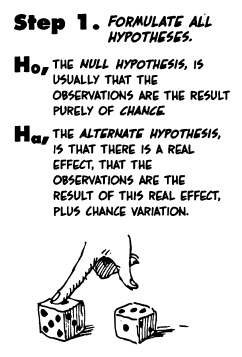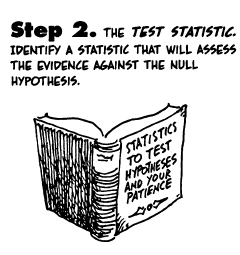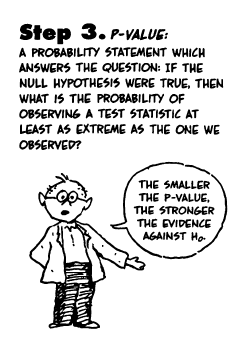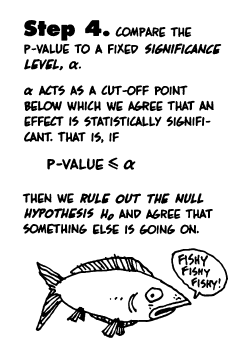12.1 How to?
The 7 Step Process of Statistical Hypothesis Testing
- Step 1: State the Null Hypothesis \(H_0\)
- Step 2: State the Alternative Hypothesis \(H_1\)
- Step 3: Set \(\alpha\) and the sample size
- Step 4: Collect Data
- Step 5: Compute the test statistic based on the sample data
- Step 6: Construct Acceptance / Rejection regions. Decide whether to reject the null hypothesis by comparing the \(p\)-value to \(\alpha\).
- Step 7: Report your results. Based on steps 5 and 6, draw a conclusion about \(H_0\)
The hypothesis that the estimate is based solely on chance is called the null hypothesis. Thus, the null hypothesis is true if the observed data (in the sample) do not differ from what would be expected on the basis of chance alone. The complement of the null hypothesis is called the alternative hypothesis.
The null hypothesis is typically abbreviated as \(H_0\) and the alternative hypothesis as \(H_1\). The two are complementary (i.e. \(H_0\) is true if and only if \(H_1\) is false)
We determine how to use sample data to evaluate the null hypothesis. The evaluation often focuses around a single test statistic. It is critical to choose and evaluate the correct test statistic: mean score, proportion, t statistic, z-score, etc.
For example, The t test tells us how significant the differences between groups are; In other words it lets us know if those differences (measured in means) could have happened by chance.
The strength of evidence in support of a null hypothesis is measured by the \(P-\)value. Suppose the test statistic is equal to \(S\). The \(P-\)value is the probability of observing a test statistic as extreme as \(S\), assuming the null hypothesis is true. If the \(P-\)value is less than the significance level, we reject the null hypothesis. We can also use the region of acceptance approach.

Interpreting results and draw conclusions is the action of applying a decision rule. If the value of the test statistic is unlikely, based on the null hypothesis, we reject the null hypothesis. That is, we conclude that the data are not sufficiently persuasive for us to prefer the alternative hypothesis over the null hypothesis.
